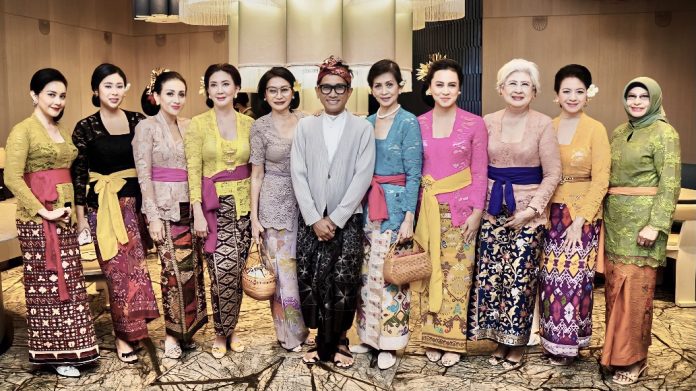JAKARTA – Once these women start to talk about art and culture, the people around them shall be alerted, because their understanding and love for it are no way less than the experts who take care of the nation’s heritage that has been passed down from generation to generation.
A group of modern women who never break away from their authentic Indonesian style from time to time seems like a decent way to describe them.
And who are they, to be honest?
Canton 108 Restaurant which is located on the second floor of Ashta Mall at SCBD’s District 8, Jakarta, appeared to be different last Saturday (21/5). It had 11 women and one man dressed in traditional Balinese kebayas cheerfully chatting and eating their meals together.
Frankly speaking, they are not ordinary people. They come from the upper class and were there to hold a reunion that evening.
The Editor had a chance to sit among them and brought up the topic about the cultural projects they had done in the past and ones they’re working on now.
And it stirred the team in awe, because they have successfully made incredible performances of Indonesia’s culture in both local and international stages.
Some of them are Sydney Opera House in Australia, Carnegie Hall in New York and UNESCO building in Paris, France.

They are the socialites who have never existed before in Jakarta.
The amount of funds they use to hold an Indonesian art performance indirectly supports the traditional artists and musicians in the country.
One of the things that caught attention from these beautiful women was their consistency to maintain the stage of Wayang Orang so it wouldn’t run out of time.
“Wayang orang is in fact another kind of opera, and opera is highly appreciated overseas. Like in Italy, European countries, Broadway in the US, ballet in Russia,” the founder of Jaya Suprana School of Performing Arts Aylawati Sarwono explained. She actively helds wayang orang art performances packed in modern technology and art, both domestically and abroad.
“So the value of wayang orang is actually not lower or higher than them. But for me, it’s obviously much higher. Why?
“Let’s take a look at western operas. They sing most of the time, but they often don’t dance. They master the orchestra. For ballet, they dance and play the orchestra very well too.
“But for wayang orang, it’s a complete package. They dance, sing, do acrobats, and also there’s humor in it. Don’t forget the live gamelan orchestra that is also included in the play.” She added.
According to her, the popularity of wayang orang in Indonesia is concerning. It’s because there are many young people who do not understand or even know about this culture.
Wayang orang is one of the traditional Javanese performing arts, especially Central Java. The story is based on Mahabharata and Ramayana which contain moral messages.
In addition to traditional theatrical performances, wayang orang is also filled with traditional dances.
It has been here since the time of Ancient Mataram and was recorded in the Wimalasmara Inscription in 930 AD and the Balitung Inscription in 907 AD (taken from the site of indonesiakaya.com/library-indonesia/wayang-orang/).
“It’s sad that we don’t really pay attention to it. Our government still pays attention to many things instead,”.
“While other countries might have been done with many things, so they can pay attention to their arts. The ballet which is crazily promoted, for example,”.
“Even though the elements of our performance are no less complete than western opera performances. Art is highly valued abroad; while here it is seen as fringe, outdated art. It’s a shame,” said Aylawati, who was seen wearing a yellow kebaya and brown cloth.
As a member of these stunning women, Aylawati said that she hopes the friendship they build together could conserve the existence of wayang orang itself and make it increasingly appreciated by society.

Giok Hartono, the owner of Djarum Group, who also attended the reunion said that this friendship which gathers women of different ages was originally formed by the same hobby, dancing a traditional dance.
And eventually, in every event they hold, it will have an impact on the lives of many people.
“Sometimes people don’t realize that dancing or theater activities not only support the artists but also many people behind it,” the woman who looked sweet in an orange kebaya, yellowish purple cloth and a white frangipani flower pinned on her left ear started her explanation.
“Those who transport goods, caterers, people who make costumes. From that one culture, many things are developed too. So in addition to reviving culture, it also provides a living for others.”
Giok admitted that she is very concerned about the salary received by the artists of wayang orang, which only reaches Rp25.000 in one performance, even though it took a very long time to prepare.
The preparation itself includes many things already, starting with make up, costumes, performances and dialogue.
So in order to gain more attention from many people, Giok and her friends participate in every stage.
Thus, business partners who are within the scope of the company of each of them who are members of the Sahabat Budaya group can participate by buying tickets.
This way means more money and more income for the artists and musicians they invite to the stage.
“Because we also take part. There is a model here, national figures like Mr. Sutiyoso (former Governor), army officers, celebrities. So the public would join to buy the tickets and watch. We also wear the shimmering costumes, ones that look better than the common artists. They are also interested in it. Don’t forget that we shorten the duration, so the audience won’t get bored watching it,” she explained while smiling.

Joeke Pamoedjo, well-known for preserving the traditional woven fabrics, regularly collecting and holding exhibitions of various Indonesian woven fabrics agreed with Ms Giok.
While laughing, she admitted that their friendship is indeed very different from the usual one.
“I have known the culture of Indonesia since I was a kid,” said Joeke.
Her love for Indonesian culture, especially its traditional dance, made her dare to introduce it to her surroundings from a young age.
Lived around the sugar factories, little Joeke actively showed various kinds of Javanese dances to every citizen who lived nearby.
“That’s right. If I see the young people, it must be their environment that influences them. Like Ms. Yessy Sutiyoso and Ms. Sarah Arifin, it’s their surroundings who love cultural things, so the love for it grows.
“For me And Mrs. Ayla, we have loved our culture since we were kids,” she added.
Sahabat Budaya Group Succeeds in Educating the Young Generation to Love Indonesian Indigenous Culture
This cross-generational friendship in fact has succeeded in merging various backgrounds in one place.
An Indonesian designer who lives in Berlin Bai Populo is the only man The Editor managed to find in this special meeting.
And, as a younger member, he admitted that he is very happy to be able to make friends in a unique way with the members of this Sahabat Budaya group.

“For me, this friendship is a bit cross-generational. We are united because we love Javanese dances, and apart from that, we are also fit to each other,” said the man who popularizes and promotes modern batik abroad as a ready-to-wear fashion.
“We really became one when we performed in Sydney, in Paris. Since then we often get together, miss each other. Everyone has the same mission, and it’s culture,” he added.
After being friends for decades, Bai continued, their friendship finally succeeded in introducing the culture as Javanese dances to all members of their family without exception.
“If the parents are interested in culture, and want to invite them, surely the children will follow,” he said.
In the end, it has an impact on the community, where a myriad of young people both from the surrounding environment and from family members immediately want to register to be part of a dancer group that specializes in dancing Javanese dances.
“I happen to have Sekar Puri, a dance studio that my friends participate in. Especially for the Javanese Solo dance,” said Sarah Arifin, a young woman who is currently continuing her grandfather Bustanil Arifin’s mandate in preserving classical puppet shows regularly in Indonesia.
One of the visions and missions that they are carrying is to make kebaya and sanggul a daily lifestyle for people in urban areas.
“Introducing kebaya at the malls, proudly wearing it,” she said while laughing.

There’s also one unique story comes from Prasanti Andrini, a dancer and co-founder of Nur Sekar Kinanti Javanese and one of the founders of Sahabat Pencinta Wayang Orang.
She said that she deliberately targets young people under the age of 30 to participate in the dissemination of this culture.
“Each of us has our own community. Like Ms. Yessy Sutiyoso has Matara Art Dance, I myself made the Nur Sekar Kinanti Studio. The vision and mission are same, to spread culture, to regenerate (I’m targeting those who are 30 years old and under),” she said.
For her, the friendship that exists in this Sahabat Budaya group is very valuable because she doesn’t want to waste time doing useless activities.
“Thinking that I’m no longer young, I have to choose friendships that do not waste time. So I only have two, friendship in terms of religion (for the afterlife) and friendship in culture,” she said.
She hopes that the government in the future will issue regulations that require citizens to have the ability to dance traditional dances and sing their respective traditional songs.
Jaya Suprana and Aylawati Sarwono Brought Wayang Orang to International Stages

The 12 years of friendship between the members of the Sahabat Budaya group have brought special experiences for Yessy Sutiyoso, the founder of the Matara Art Center and a kindergarten school which runs a curriculum that is guided by indigenous Indonesian culture.
“I met these friends in this Sahabat Budaya group in 2010, so it’s been more or less than 12 years. We initially met because we have a common liking for watching and dancing wayang orang. Then we practice together, with our respective roles,” she said.
The graduate majoring in Socio-Cultural Affairs from the University of Indonesia said that the Sydney Operas House in Australia was the first stage they had managed to line up.
She said that Jaya Suprana–a musician, culturalist and the owner of Jamu Jago–and his wife Aylawati Sarwono are the two people who work the hardest to bring these women to the world stage.

“First stage is the Sydney Opera House in Australia. Mrs. Ayla and Mr. Jaya Suprana had the opportunity to take us there,” she said.
So far, she continued, improving the living standards of the artists and dancers involved in Wayang Orang is the group’s main target.
And during the current corona pandemic, introducing art performances by inviting relatives to buy tickets is one of the most effective ways to bring the performing arts to life.
“Sometimes we do performances aimed at helping communities that need help, such as Barata. During the pandemic, there is no income. So if we take part in the play, the tickets can be sold quickly.
“We just need to bring our own families, there are already a lot of audiences, then our friends outside this group.
“My art studio also aims to introduce our nation’s culture from an early age, from Sabang to Merauke. So at least the children know the culture,” she concluded.
Children Start Learning to Appreciate Indonesian Culture
Making friends with the women from various backgrounds and different age ranges make young people like Gendhis Suharto more enthusiastic in learning to appreciate her own culture.
The woman who is the head of the GNOTA Foundation (the national movement for foster parents) admitted that she only knew batik without understanding its meaning and philosophy at first.
“I started to learn and appreciate culture more. Because they [the women] are really into culture, so I learn a lot. For example, I then only knew batik, but didn’t know what batik was. Now I know that there are many kinds of batik,” she said.

She was actually invited by Aylawati Sarwono to participate in the wayang orang performance at the Istana Negara in 2010.
Although she was familiar with traditional dances when she was in elementary school, for Gendhis, she was able to get to know the culture of Indonesia more after she often hung out with members of the Sahabat Budaya group.
“At that time, Ms. Sarah and I joined Ms. Yessy’s studio. Then, in 2010, I was invited by Ms. Ayla to fill out an event at the palace, to take part in the upcoming wayang orang performance.
“I’ve been interested in folk dances since elementary school. Since I met them, I’ve been practicing a lot. Personally, I am really interested in culture, but just have gotten into it when I often hang out with them,” she explained.
Up To The Stage With Aylawati Sarwono
A top model in the 1980s, Enny Sukamto, was one of the women The Editor met at a Canton restaurant.

Even though she had just recovered from sick, Enny’s beauty seemed timeless. Especially when she expressed her joy to meet her best friend from the Sahabat Budaya group.
“I’m really happy for this friendship wherein we became close. Because it’s a group, we just stick together,” said Enny, who was seen wearing a blue kebaya and light brown cloth with floral motifs.
Enny admitted that her happiness remains the same as from the beginning when she joined Aylawati Sarwono to help the wayang orang community to become famous again as it is today.
At that time, said Enny, Aylawati deliberately invited people from the fashion world to boost the popularity of the wayang orang show.
“Yes, it was from Ayla, from the wayang orang community, Mrs. Ayla invited fashion people to help the wayang orang community to become famous again. Well, so I followed behind Mrs. Ayla,” she said.
 Aylawati also confirmed Enny’s words. She admitted that she had deliberately gathered people with such backgrounds to encourage this culture to survive.
Aylawati also confirmed Enny’s words. She admitted that she had deliberately gathered people with such backgrounds to encourage this culture to survive.
Because, so far, Aylawati said that their friendship was able to help support the artists behind the screen of her wayang orang.
“By gathering these caring mothers and fathers, those who want to dance, want to spend money, want to practice, want to play,” she said.
Of course, the artists of wayang orang can get additional income from each performance they make. Because they can have the opportunity to train the players as a whole and get an honorarium as well because they have the opportunity to perform together.
Now, are you ready to introduce your culture as well as these beautiful women? Waiting for your comments in The Editor’s email.




